| Pages:
1
2
3
4
5
6 |
aga
Forum Drunkard
    
Posts: 7030
Registered: 25-3-2014
Member Is Offline
|
|
Unfortunately i dumped the dried ethanol from the previous experiment into my ethanol reserve, so to test some ideas i made a small qty more with the
remaining K3PO4.
The same bi-phasic phenomenon was observed with the ethanol quickly moving to the Upper layer.
Here is the Upper layer with some KMnO4 as suggested by softbeard with the right hand tube containing distilled water +
postassium permanganate for comparison.
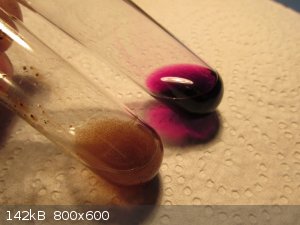
Whilst cleaning up (~1 hour) it was noted that the KMnO4 had fallen out of suspension and was only seen on the bottom of the test tube.
As suggested by Tsjerk a single CuSO4.5H2O crystal was covered with the dried ethanol.
No immediate colour change was noted in either the liquid or the crystal.
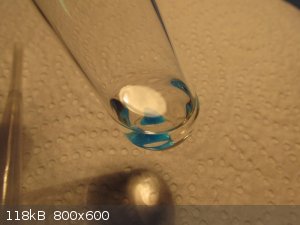
After 15 minutes a colour change had occurred in the crystal, but not the liquid.
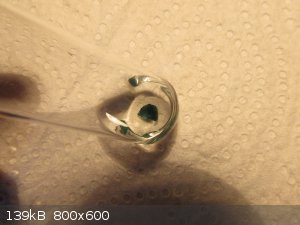
Next on to the suggestion made by Starcruiser, which was rather more arduous.
100g of copper sulphate crystals was dried in an oven at ~150 C for two hours, with periodic removal, crushing and spreading of the crystals, yeilding
a not-quite-white powder (still had a slight green tinge).
The resulting drier copper sulphate weighed 68.86g, representing approximately 86% of the crystal water removed.
10ml of the the 37% Vodka was diluted with 10g of solidified tap water. To this was added around 20ml of a citrate extraction.
This was mixed, then added to the amateur chemist 
Next 80ml of the Vodka was measured with a cylinder and poured into a 100ml beaker.
Theoretically the water in 80ml should be absorbed by 28g of anhydrous copper sulphate, so 28g was added as a starting point, and mixed thoroughly.
The powder immediately became Blue again and slight heating was noted.
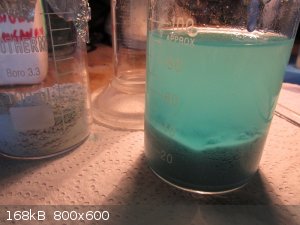
After 10 minutes nothing remarkable was seen, so more of the dried powder was added and mixed.
After adding a further 10g, there was no room to add more.
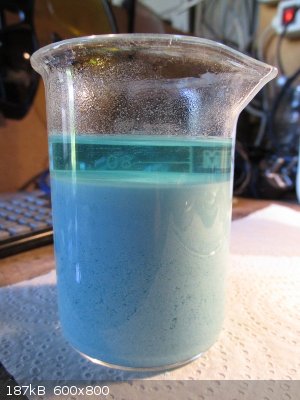
Some of this blue liquid was tested in the refractometer, and measured at 46w% EtOH.
This is a light-based instrument, so it is highly likely that the blue colouration affected this result.
To test the Colour effect, a small quantity of the dried powder was dissolved in distilled water to match the colour of the liquid in the beaker as
close as practicable by eye.
This measured 7w% despite there being no EtOH in there.
Made reckless by the Vodka & Orange from earlier, i set light to the liquid in the beaker.
It burned merrily with a colourless flame, so it is likely that some degree of water sequestration had happened.
Overall the Anhydrous Copper Sulphate method left the Ethanol layer with a significant quantity of water, as the Blue colour testifies (no water, no
ions, no Blue).
By comparison, the dried copper sulphate would not dissolve at all in the Ethanol produced by the tripotassium phosphate method.
Please deride, slate and comment.
|
|
|
deltaH
Dangerous source of unreferenced speculation
    
Posts: 1663
Registered: 30-9-2013
Location: South Africa
Member Is Offline
Mood: Heavily protonated
|
|
Very thorough work again aga, well done!
|
|
|
deltaH
Dangerous source of unreferenced speculation
    
Posts: 1663
Registered: 30-9-2013
Location: South Africa
Member Is Offline
Mood: Heavily protonated
|
|
Yes, it's standard industrial equipment run as a series under reduced pressure that gets incrementally lower and lower in the evaporators. In a
nutshell, it's a way of evaporating a liquid to concentrate a solution in a more energy efficient way than doing it in just one heated step. You use
the vapour from a previous step at a higher pressure to boil the liquid in the next step and so convert some of the heat of condensing the vapour into
boiling the liquid. Overall you still need net heat, but by recovering the heat of condensing the vapour, you save on a lot of energy.
Read more here: https://en.wikipedia.org/wiki/Multiple-effect_evaporator
|
|
|
deltaH
Dangerous source of unreferenced speculation
    
Posts: 1663
Registered: 30-9-2013
Location: South Africa
Member Is Offline
Mood: Heavily protonated
|
|
It would be interesting to see what percentage alcohol results when using potassium carbonate.
We already know that it does form a second liquid layer from the opening post's reference, just not what concentration results.
If it too makes an absolute alcohol, then sure, it would be preferable.
[Edited on 13-11-2015 by deltaH]
|
|
|
aga
Forum Drunkard
    
Posts: 7030
Registered: 25-3-2014
Member Is Offline
|
|
Ah crap.
OK. So do the same with potassium carbonate.
Think i'll just buy that reagent this time.
|
|
|
deltaH
Dangerous source of unreferenced speculation
    
Posts: 1663
Registered: 30-9-2013
Location: South Africa
Member Is Offline
Mood: Heavily protonated
|
|
It's solubility is 112g/100ml water, so you could use a little more to saturate the solution than what you did with K3PO4.
[Edited on 13-11-2015 by deltaH]
|
|
|
aga
Forum Drunkard
    
Posts: 7030
Registered: 25-3-2014
Member Is Offline
|
|
One would do a calculation or two in any event.
Thanks for looking up the solubility.
|
|
|
aga
Forum Drunkard
    
Posts: 7030
Registered: 25-3-2014
Member Is Offline
|
|
Before i get going with any more experiments, are there any OTHER substances to test in this application ?
May as well get the whole series sorted in one go.
|
|
|
MolecularWorld
Hazard to Others
  
Posts: 110
Registered: 30-10-2015
Member Is Offline
Mood: No Mood
|
|
You could try trisodium phosphate.
I wanted to try this tripotassium phosphate process, but I don't have alkaline potassium compounds or phosphoric acid.
What I do have is trisodium phosphate, available as a cleaning product* at many hardware stores.
I also don't have vodka or similar ethanol solution, but I did have some old cheap whiskey (40% ABV), and 40% methanol solution (winter windshield
washer fluid).
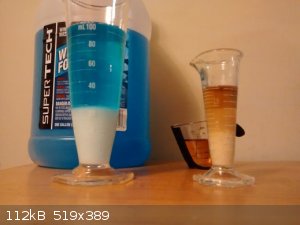
The trisodium phosphate appears to work for separating ethanol from solution. I lack the means to determine the concentration of the top layer, but it
burned readily with a blue flame, leaving a small amount of carbonaceous residue that smelled of burnt sugar. The volume was close to what would be
expected in a complete separation.
It also appears that trisodium phosphate is unsuitable for separation of methanol from solution. There is no obvious separation. The white layer on
the bottom is undissolved trisodium phosphate. Liquid extracted from the top only burned once heated to boiling, and evaporated to leave
sodium-containing residue.
*This is being phased out in favor of misleadingly labeled TSPsubstitute. Be sure your TSP is real, the substitutes are useless.
[Edited on 14-11-2015 by MolecularWorld]
|
|
|
UC235
National Hazard
   
Posts: 565
Registered: 28-12-2014
Member Is Offline
Mood: No Mood
|
|
Quote: Originally posted by MolecularWorld  | You could try trisodium phosphate.
I wanted to try this tripotassium phosphate process, but I don't have alkaline potassium compounds or phosphoric acid.
What I do have is trisodium phosphate, available as a cleaning product* at many hardware stores.
I also don't have vodka or similar ethanol solution, but I did have some old cheap whiskey (40% ABV), and 40% methanol solution (winter windshield
washer fluid).
The trisodium phosphate appears to work for separating ethanol from solution. I lack the means to determine the concentration of the top layer, but it
burned readily with a blue flame, leaving a small amount of carbonaceous residue that smelled of burnt sugar. The volume was close to what would be
expected in a complete separation.
It also appears that trisodium phosphate is unsuitable for separation of methanol from solution. There is no obvious separation. The white layer on
the bottom is undissolved trisodium phosphate. Liquid extracted from the top only burned once heated to boiling, and evaporated to leave
sodium-containing residue.
*This is being phased out in favor of misleadingly labeled TSPsubstitute. Be sure your TSP is real, the substitutes are useless.
[Edited on 14-11-2015 by MolecularWorld] |
Check your MSDS too. "TSP" as sold is frequently just a mix of TSP and sodium sesquicarbonate with traces of sodium silicate. I think they neutralize
crude phosphoric acid produced from sulfuric acid and calcium phosphate with trona in excess, dry the result, and throw it in a box. It is far from
pure, but not a bad starting point.
In fact, here is the MSDS from the page you linked. http://www.homedepot.com/catalog/pdfImages/5b/5b08c5e5-d610-...
[Edited on 14-11-2015 by UC235]
|
|
|
MolecularWorld
Hazard to Others
  
Posts: 110
Registered: 30-10-2015
Member Is Offline
Mood: No Mood
|
|
The TSP I used above is the same brand as at the link.
I never said it was pure, and my experiment shows it doesn't have to be.
I didn't even dry it before use.
I read the MSDS (how'd you think I knew it was real?), and as you said, there is some "sodium sesquicarbonate", but at a low enough concentration that
it could still be called technical-grade trisodium phosphate.
The substitutes are completely different. They contain no phosphate (the phase-out is supposedly to reduce phosphates in runoff), and may be any
number of other compounds (I almost bought one that turned out to be mostly "sodium metasilicate").
[Edited on 14-11-2015 by MolecularWorld]
|
|
|
deltaH
Dangerous source of unreferenced speculation
    
Posts: 1663
Registered: 30-9-2013
Location: South Africa
Member Is Offline
Mood: Heavily protonated
|
|
Thank you MolecularWorld for your contribution and work!
I have one more potential trick up my sleeve in regards to this... salting out dilute ammonia solutions.
You almost certainly wouldn't make a second liquid layer, but instead, lots of ammonia vapour which you could lead via a pipe and into ice to make
concentrated and pure ammonia solution. The ice is very important to help with absorption since this is very exothermic for ammonia.
OK, I know it's not that impressive, but still, if you need 25% ammonia solution and all you can get is store bought scrubs ammonia solutions
contaminated with detergent...
[Edited on 14-11-2015 by deltaH]
|
|
|
deltaH
Dangerous source of unreferenced speculation
    
Posts: 1663
Registered: 30-9-2013
Location: South Africa
Member Is Offline
Mood: Heavily protonated
|
|
aga, there are a great many other salts that could be tested. In my mind I have the following hypothesis in terms of efficacy:
K3PO4 > K2CO2~Na3PO4~K2SO4~(NH4)2SO4 > Na2CO3~Na2SO4~KCl~NH4Cl > NaCl
... but for the sake of brevity, you might only want to try a select few.
[Edited on 14-11-2015 by deltaH]
|
|
|
MolecularWorld
Hazard to Others
  
Posts: 110
Registered: 30-10-2015
Member Is Offline
Mood: No Mood
|
|
I just saturated some crappy dollar store ~2% ammonia solution with crappy hardware store trisodium phosphate.
The results were inconclusive.
Very slight effervescence was seen.
The ammonia odor was, if anything, reduced, suggesting the ammonia is reacting with either the phosphate or carbonate.
Someone with pure phosphates and somewhat stronger (~5%) ammonia solution should attempt this to allow for better observations.
|
|
|
deltaH
Dangerous source of unreferenced speculation
    
Posts: 1663
Registered: 30-9-2013
Location: South Africa
Member Is Offline
Mood: Heavily protonated
|
|
Thanks MolecularWorld. I don't think you can have any carbonate in there though, that would sink ammonia to form carbamate anions
(NH2COO-) in a fast equilibrium.
You really need relatively pure and anhydrous salts, carbonate free.
|
|
|
deltaH
Dangerous source of unreferenced speculation
    
Posts: 1663
Registered: 30-9-2013
Location: South Africa
Member Is Offline
Mood: Heavily protonated
|
|
Just read about the terrible attacks in Paris, my condolences to all our French SM members, how terrible 
|
|
|
deltaH
Dangerous source of unreferenced speculation
    
Posts: 1663
Registered: 30-9-2013
Location: South Africa
Member Is Offline
Mood: Heavily protonated
|
|
Chatting to aga, I have had a speculative brain wave... adding K3PO4 to concentrated ammonia solution (34%) might result in extreme
cooling.
Why?
The idea is that the K3PO4 dissolves in the conc. ammonia solution, interacts strongly with the water there making the ammonia not want to hang around
anymore. The ammonia then boils off, but this is highly endothermic (ammonia has a high heat of vaporization) and so the remaining solution gets
colder and colder. Kind of like boiling liquefied gases rapidly out of a gas cylinder causing the cylinder to get colder and colder. If we're REALLY
lucky and this goes to extremes, something amazing just might happen, but I don't want to say what just yet because the chances of it happening are
pretty slim, anyway, some of you might guess...
Unfortunately one would need a really good fume cupboard for this because of the large amounts of ammonia fumes generated.
[Edited on 14-11-2015 by deltaH]
|
|
|
Tsjerk
International Hazard
    
Posts: 3022
Registered: 20-4-2005
Location: Netherlands
Member Is Offline
Mood: Mood
|
|
Unfortunately I only remembered about this experiment (absolute ethanol/ CuSO4 pentahydrate) the moment I went home yesterday. I did start the
experiment but also I didn't see an immediate change of color. The tube is sealed air tide, and I will have a look at it Monday morning.
The ethanol I used comes in as 99,9%+ P.A. absolute ethanol, so not completely anhydrous. Also people don't care about moisture from the air coming in
because we don't need it to be anhydrous. But I think it should still be close to anhydrous as the bottle was pretty new. I will let you know, I also
took a picture before and after adding the ethanol.
|
|
|
softbeard
Hazard to Self
 
Posts: 69
Registered: 23-7-2013
Member Is Offline
Mood: moody
|
|
Quote: Originally posted by aga  | Unfortunately i dumped the dried ethanol from the previous experiment into my ethanol reserve, so to test some ideas i made a small qty more with the
remaining K3PO4.
The same bi-phasic phenomenon was observed with the ethanol quickly moving to the Upper layer.
Here is the Upper layer with some KMnO4 as suggested by softbeard with the right hand tube containing distilled water +
postassium permanganate for comparison. |
Hey Aga, that potassium permanganate dissolution test looks really convincing! If I remember right, KMnO4 in 95% ethanol gives a barely
perceptible pink colour. Looks like in your test you just got a trace of Mn3O4 suspension, no KMnO4 dissolving at
all.
Maybe do a comparison test with the potassium permanganate in one test tube with 95% ethanol and the other tube with potassium permanganate and the
K3PO4-dried ethanol.
BTW: I think it's great you doing these experiments and showing the pictures! I'll be trying some ethanol drying with the K3PO4
when I get some time. Phosphoric acid, I got. I think it's time to look for some K2CO3 on eBay. 
|
|
|
aga
Forum Drunkard
    
Posts: 7030
Registered: 25-3-2014
Member Is Offline
|
|
All i got is a fully equipped Shed and the Will to spend about 4 hours Doing Stuff.
Most people have a phone that does photos these days.
Unfortunately i stuck a contaminated 10ml pipette in the Ethanol reserve (250ml bottle) and now it's all milky.
Sodium thiopsulphate maybe, maybe some silver chloride, not sure.
Needs distilling again certainly.
Anyone can Do experiments, and more people Should.
Get some potassium carbonate and Test this thing !
[Edited on 14-11-2015 by aga]
|
|
|
deltaH
Dangerous source of unreferenced speculation
    
Posts: 1663
Registered: 30-9-2013
Location: South Africa
Member Is Offline
Mood: Heavily protonated
|
|
softbeard, be aware that K3PO4 is a foaming agent and also that these solutions become viscous, so not so sure K2CO3 would be the
best feedstock to use, I'd use KOH as aga did, taking great care, of course.
I see on alibaba.com that there are many sellers selling anhydrous food grade K3PO4, abbreviated as ATKP. It's a mere $1-2/kg in bulk quantities, if
only it were that easy 
|
|
|
aga
Forum Drunkard
    
Posts: 7030
Registered: 25-3-2014
Member Is Offline
|
|
Quote: Originally posted by deltaH  | | Chatting to aga, I have had a speculative brain wave... adding K3PO4 to concentrated ammonia solution (34%) might result in extreme
cooling. |
It seems to result in extreme ammonia production at least !
A cork was drilled to accept some glass piping and a glass thermometer.
A plastic tube was attached to the glass pipe and connected to an inverted funnel to serve as anti-suckback in a 250ml beaker containing iced water.
10g of dried K3PO4 was loaded into a 25ml RBF.
10ml of 33w% aqueous NH3 was injected into the RBF via a hypodermic syringe via the take-off pipe in two portions (the biggest hypodermic
on hand was 5ml).
A reaction was noticed immediately on adding the first few drops of ammonia.
Unfortunately the gas evolution from the flask prevented further ammonia being added (the liquid kept bubbling up the pipe, and not into the RBF) so
the cork was released, and the ammonia injected.
On re-seating the cork, strong bubbling of ammonia was seen in the scrubbing beaker.
The RBF became cold to the touch, although not freezing.
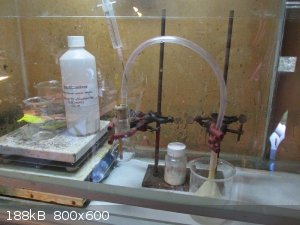
The scrubber liquid was tested with UI paper and is strongly basic.
[Edited on 21-11-2015 by aga]
|
|
|
aga
Forum Drunkard
    
Posts: 7030
Registered: 25-3-2014
Member Is Offline
|
|
Hmm.
Comparing the effectiveness of tri-K and Na Phosphate sounds like a great idea.
With any luck, may get that done tomorrow, depending on how well the product of H3PO4 + NaOH dries.
For the last K attempt i found a stainless steel dog bowl to be most effective.
|
|
|
aga
Forum Drunkard
    
Posts: 7030
Registered: 25-3-2014
Member Is Offline
|
|
Comparison of Tri Potassium Phosphate and Potassium Carbonate
This experiment was intended to quantitatively compare the salting-out efficiency of the two chemicals in an ethanol/water separation.
15ml Ethanol was diluted with 35ml of distilled water to form the 'feedstock'.
This concentration was tested with a refractomer to be 31 w% <sup>(1)</sup>.
Two test tubes were filled with ~6ml of the feedstock.
To one was added 1.20g dry (homemade) K3PO4
The other had 5.47g of K2CO3 added.
These amounts were determined by first weighing the reagents, then adding spatulas of the reagent to the test tube, shaking, and repeating until no
further reagent would dissolve.
The reagents were then re-weighed, the difference in weight being the quantity used.
(this simple technique is called accurately adding stuff to other stuff to see what happens)
The test tubes were allowed to stand.
Phase separation occurred in both test tubes, with the K3PO4 sample achieving stable phases after 30 seconds.
The K2CO3 sample did not heat very much at all, and took ~8 minutes to achieve stable phases.
The K3PO4 sample created 3 phases, presumably due to either insufficient reagent, or (highly likely) a lot of impurities in this
home-made batch.
Presuming the upper layers to be in the 90+ w% range, direct reading would not be useful with the refractometer as the scale is logarithmic, with the
lower part of the scale being more accurate.
So 1ml of each liquid phase was drawn off in a pipette and mixed with 1ml DIW.
This 50% diluted solution was then tested, with the result doubled to arrive back at the actual w%.
The Results were :-
Upper K3PO4 layer : 56w%
Lower K3PO4 layer : 78w%
Upper K2CO3 layer : 100w%
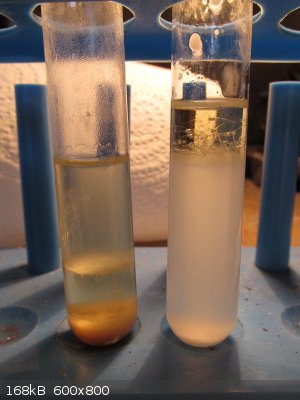
Conclusions:-
Pure potassium carbonate works very well in the salting out of ethanol, although is much slower than tripotassium phosphate.
The experiment needs to be repeated with equally pure reagents to determine the exact times to achieve the effects, the heating
generated and the actual quantities of ethanol recovered.
<sup>(1)</sup>
Yes, 31w% = 103w% in the original ethanol. This is not a 100% accurate analytical lab ...
Please deride, slate and comment.
|
|
|
deltaH
Dangerous source of unreferenced speculation
    
Posts: 1663
Registered: 30-9-2013
Location: South Africa
Member Is Offline
Mood: Heavily protonated
|
|
Interesting that the K2CO3 also gave 100%! I'm amazed this isn't more common knowledge.
Looks like you have some metallic contamination in this K3PO4 batch this time (not that it should matter much) and I suspect you didn't use enough of
it, hence the lower alcohol purity.
Thanks again for your contribution and nice work!
|
|
|
| Pages:
1
2
3
4
5
6 |